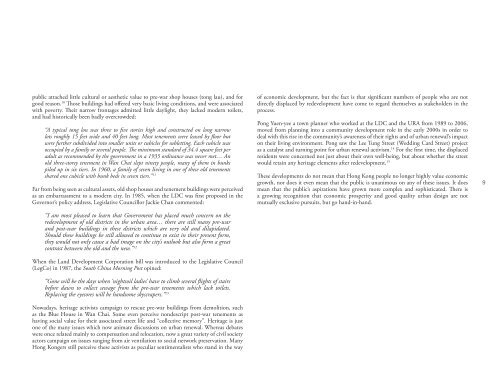Treating the Symptoms - A Critical Review of ... - Civic Exchange
Treating the Symptoms - A Critical Review of ... - Civic Exchange
Treating the Symptoms - A Critical Review of ... - Civic Exchange
- No tags were found...
Create successful ePaper yourself
Turn your PDF publications into a flip-book with our unique Google optimized e-Paper software.
public attached little cultural or aes<strong>the</strong>tic value to pre-war shop houses (tong lau), and forgood reason. 10 Those buildings had <strong>of</strong>fered very basic living conditions, and were associatedwith poverty. Their narrow frontages admitted little daylight, <strong>the</strong>y lacked modern toilets,and had historically been badly overcrowded:“A typical tong lou was three to five stories high and constructed on long narrowlots roughly 15 feet wide and 40 feet long. Most tenements were leased by floor butwere fur<strong>the</strong>r subdivided into smaller units or cubicles for subletting. Each cubicle wasoccupied by a family or several people. The minimum standard <strong>of</strong> 34.4 square feet peradult as recommended by <strong>the</strong> government in a 1935 ordinance was never met… Anold three-storey tenement in Wan Chai slept ninety people, many <strong>of</strong> <strong>the</strong>m in bunkspiled up in six tiers. In 1960, a family <strong>of</strong> seven living in one <strong>of</strong> <strong>the</strong>se old tenementsshared one cubicle with bunk beds in seven tiers.” 11Far from being seen as cultural assets, old shop houses and tenement buildings were perceivedas an embarrassment to a modern city. In 1985, when <strong>the</strong> LDC was first proposed in <strong>the</strong>Governor’s policy address, Legislative Councillor Jackie Chan commented:“I am most pleased to learn that Government has placed much concern on <strong>the</strong>redevelopment <strong>of</strong> old districts in <strong>the</strong> urban area… <strong>the</strong>re are still many pre-warand post-war buildings in <strong>the</strong>se districts which are very old and dilapidated.Should <strong>the</strong>se buildings be still allowed to continue to exist in <strong>the</strong>ir present form,<strong>the</strong>y would not only cause a bad image on <strong>the</strong> city’s outlook but also form a greatcontrast between <strong>the</strong> old and <strong>the</strong> new.” 12When <strong>the</strong> Land Development Corporation bill was introduced to <strong>the</strong> Legislative Council(LegCo) in 1987, <strong>the</strong> South China Morning Post opined:“Gone will be <strong>the</strong> days when ‘nightsoil ladies’ have to climb several flights <strong>of</strong> stairsbefore dawn to collect sewage from <strong>the</strong> pre-war tenements which lack toilets.Replacing <strong>the</strong> eyesores will be handsome skyscrapers.” 13Nowadays, heritage activists campaign to rescue pre-war buildings from demolition, suchas <strong>the</strong> Blue House in Wan Chai. Some even perceive nondescript post-war tenements ashaving social value for <strong>the</strong>ir associated street life and “collective memory”. Heritage is justone <strong>of</strong> <strong>the</strong> many issues which now animate discussions on urban renewal. Whereas debateswere once related mainly to compensation and relocation, now a great variety <strong>of</strong> civil societyactors campaign on issues ranging from air ventilation to social network preservation. ManyHong Kongers still perceive <strong>the</strong>se activists as peculiar sentimentalists who stand in <strong>the</strong> way<strong>of</strong> economic development, but <strong>the</strong> fact is that significant numbers <strong>of</strong> people who are notdirectly displaced by redevelopment have come to regard <strong>the</strong>mselves as stakeholders in <strong>the</strong>process.Pong Yuen-yee a town planner who worked at <strong>the</strong> LDC and <strong>the</strong> URA from 1989 to 2006,moved from planning into a community development role in <strong>the</strong> early 2000s in order todeal with this rise in <strong>the</strong> community’s awareness <strong>of</strong> <strong>the</strong>ir rights and <strong>of</strong> urban renewal’s impacton <strong>the</strong>ir living environment. Pong saw <strong>the</strong> Lee Tung Street (Wedding Card Street) projectas a catalyst and turning point for urban renewal activism. 14 For <strong>the</strong> first time, <strong>the</strong> displacedresidents were concerned not just about <strong>the</strong>ir own well-being, but about whe<strong>the</strong>r <strong>the</strong> streetwould retain any heritage elements after redevelopment. 15These developments do not mean that Hong Kong people no longer highly value economicgrowth, nor does it even mean that <strong>the</strong> public is unanimous on any <strong>of</strong> <strong>the</strong>se issues. It doesmean that <strong>the</strong> public’s aspirations have grown more complex and sophisticated. There isa growing recognition that economic prosperity and good quality urban design are notmutually exclusive pursuits, but go hand-in-hand.9
















